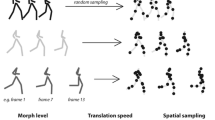Abstract
In this research, we examined the tactile sense for sensory substitution in people who have lost one sense. We considered the use of apparent movement to communicate something via the tactile sense. It is necessary to measure the apparent movement objectively and quantitatively because apparent movement is normally a subjective thing. We extracted swing motion, a vital reaction characteristic accompanied by apparent movement, by using electromyography (EMG). We presented individual stimuli and performed a t-test with a combination of the stimuli presented. From the t-test results, the difference in the vital reaction characteristic for each combination of stimuli presented was not small. The result presented here was obtained using only one subject, and therefore it will be necessary to increase the number of subjects in future.
Similar content being viewed by others
Explore related subjects
Discover the latest articles and news from researchers in related subjects, suggested using machine learning.References
Domenici C, Derossi D (1992) A stress-component-selective tactile sensor array. Sensors Actuators 13:97–100
Gray BL, Fearing RS (1996) A surface micro-machined microtactile sensor array. IEEE Int Conf Robotics Autom 1:1–6
Pawuk D, Buskirk C, Killebrew J, et al (1998) Control and pattern specification for a high density tactile array. IMECE Proc ASME Dyn Syst Control Div 64:97–102
Uchida M, Tanaka H, Ide H, et al (2006) A tactile display by 16 kinds of modulated wave vibration using only one PZT vibrator (in Japanese). T IEE Jpn 120-C(6):825–830
Shiozaki T, Uchida M, Tanaka H, et al (2002–9) The evaluation of cognition to modulated vibration stimulus by ERP (in Japanese). T IEE Jpn 122-C(9):1567–1572
Uchida M, Nozawa A, Ide H (2004-1) Difference evaluation of modulated vibration stimuli by using single trial waveform of ERP (in Japanese). IEEJ Trans EIS 124(1):73–78
Kirman JH (1974) Tactile apparent movement: the effects of interstimulus onset interval and stimulus. Perception Psychophys 15:1–6
Kirman JH (1974) Tactile apparent movement: the effects of number of stimulators. J Exp Psychol 103:1175–1180
Kirman JH (1983) Tactile apparent movement: the effects of shape and type of motion. Perception Psychophys 34:96–102
Ueda S, Uchida M, Nozawa A, et al (2007–6) A tactile display used phantom sensation with apparent movement together (in Japanese). IEEJ Trans FM 127(6):277–284
Author information
Authors and Affiliations
Corresponding author
Additional information
This work was presented in part at the 15th International Symposium on Artificial Life and Robotics, Oita, Japan, February 4–6, 2010
About this article
Cite this article
Park, Yi., Uchida, M. Swing analysis of body-parts motion accompanied by apparent movement. Artif Life Robotics 15, 491–495 (2010). https://doi.org/10.1007/s10015-010-0851-2
Received:
Accepted:
Published:
Issue Date:
DOI: https://doi.org/10.1007/s10015-010-0851-2




